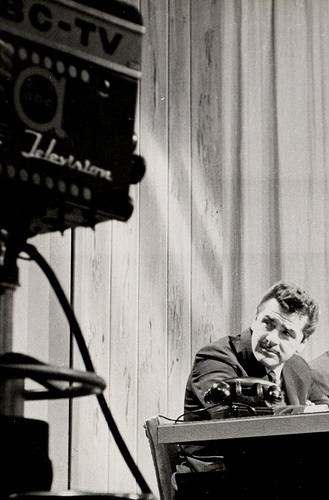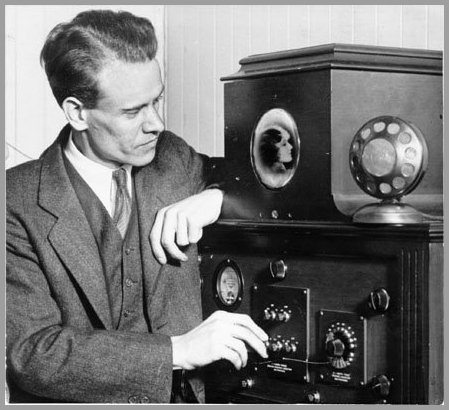Motor Mouth: Bob Dobbs (Pt1)
19 Feb 2010
Craig Baldwin: Please introduce yourself.
Bob Dobbs: I am a negentropist. And I am Bob Dobbs, I was born in 1922 in Paris and I've been working with the Secret Council of Ten (SCT) since the 1940s. The SCT has been dismantled and I'm the only person left dealing with the effects of it and that's where I am today.
CB: I understand you consider yourself a media ecologist.
BD: Yes, "media ecologist" is a term I used in the 1980s because it was not known. But now Wired Magazine is a media ecologist, so it's gone mainstream. The real meaning of media ecology for me was not to turn media off and go back, rather it was a means to move forward and keep the non-entropic process happening--so that's negentropy, so I am a negentropist now in the 1990s.

CB: How does this have to do with mixed corporate-media?
BD: Well, speech is a mixed corporate-medium in the sense that language was the first technology that created community. It was the tool that people could develop a consensus with. And language was the first medium and it contained all the possible extensions and fragmentations of it which are technological inventions. So all future media were implied in speech. And mixed corporate-media in the twentieth century sense is the computer environment using movies, radio, TV, and satellite. So the mixed electronic phenomenon we know in the twentieth century of mixed corporate-media recapitulates the initial virgin state of speech, so the tactile quality of speech is mimed and fulfilled self-consciously by the electrification of speech, which is the mixed corporate-media thing fragmented and then re-imploded. So mixed corporate-media today is the squaring of the implications of our first medium, speech. So language is a mixed corporate-medium, and the electric environment is Mixed Corporate Media.

CB: Please explicate your concept of the discarnate entity in the mixed corporate-media matrix.
BD: There's no such state as the discarnate state. Every medium starting with language is an extension of us, so it's *human*. Even though we think of machines as not us, they are made by humans. Look at a book, it has a simulation of the the visual experience. It is an extension of the eye. So it is an amplification of the eye. It's not that it's *not* an eye, it is an *amplification* of the eye. So it is part of our human bodies. Mixed corporate-media disappeared by 1977, and since then we've lived in a 'negativland,--an afterimage situation. By 1993 Wired Magazine had first retrieved McLuhan, who emphasized the discarnate condition. That condition was first described though by Wyndham Lewis and James Joyce in the 1920s. It is a normal perception now, something that people understand, it's obvious to them, it's a rearview mirror reflex reaction. The discarnate state has become a buzz phrase in pop culture. My job is to point out that it doesn't mean we've lost our bodies, it's just that we live in an environment that's invisible, that's inaudible, is tactility--which is not a sense, it is the interplay of the senses. Mixed corporate-media is an extension of the tactile sense. It is a platform that incorporates all the senses, like a CD-ROM. This tactility is human, it is in us, we extend it, it is human. The discarnate state is a natural fulfillment of speech becoming aware of itself.

CB:Can you talk about the difficulty of establishing reference points?
BD: How does humanity retrieve human scale, or the anthropomorphic image? We have standard reference points of how humans look--2 arms, 2 legs, and all this stuff. Most people don't think of their automobile as part of their organism or sensory life while they are driving. From 1750 to 1900, you have these huge metallic steel newspaper environments that look very inhuman. They were extensions and amplifications of our muscular structure, so they are extensions of our bodies. And the extension of the central nervous system we're talking about starts with the electronic revolution at the turn of the century, beginning with the telegraph. It really blossoms in the 1900s through the 1920s. That's where people start to subconsciously think "we don't even have bodies anymore." The industrial age with its pollutants is considered inhuman to small communities and to personal identity. Individuals now cannot put their signature on objects they make. ...Or even know where the apparatus they are making is going, or for what purpose! For example I knew a person that worked on the first satellites that NASA put up and he didn't even know he was working on the satellite, it was top secret. That kind of impersonality is generally associated with the mechanical age and that is considered nonhuman scale, even though humans still had lives all through the last two thousand years and were interacting with people. The problem was that language, the way people communicated with each other, was aborted by the larger linguistic structures of the industrial revolution, which sort of altered how people communicated about what was going on. So, it was always a communication problem--because people still go on living in their bodies.